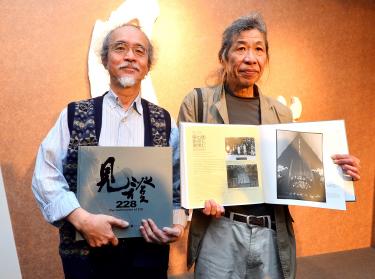As the nation prepares to mark the 68th anniversary of the 228 Incident on Saturday, the 228 Memorial Foundation yesterday released a collection of photographs and interviews recounting the stories of families affected by the massacre.
Completed over a course of five years, the two-volume collection, titled Testimonies of 228 (見證228), features black-and-white portraits of the people interviewed, who include both elderly survivors and family members from around the nation.
Short excerpts from the interviews are presented in both Mandarin and English.
The compilation was produced by photojournalist Pan Hsiao-shia (潘小俠), human rights activist and oral history expert Chen Ming-cheng (陳銘城) and historian and former political prisoner Yang Bi-chuan (楊碧川).
Over the course of four years, beginning in 2010, the trio traveled across the nation to interview a total of 228 families who were affected by the incident.
Pan embarked on the journey after he completed a photojournalism project focusing on victims of political prosecution during the White Terror era, which followed the 228 Incident and reached its peak during the 1950s and 1960s.
“We interviewed so many people. While the stories were different, they evoked the same emotions,” Yang said, adding that through the work of historians, Taiwanese have slowly uncovered the truth about the 228 Incident.
The foundation said that photographs and images related to the 228 Incident are scarce because the incident was considered taboo during the Martial Law era.
The Incident began on the afternoon of Feb. 27, 1947, when six agents of the Monopoly Bureau’s Taipei branch tried to confiscate illegal cigarettes that widow Lin Chiang-mai (林江邁) was selling in front of the Tien-ma Tea House and her money. After she refused to hand over her stock, she was pistol-whipped on the head and passed out, triggering protests from bystanders. As the agents fled the scene, they opened fire on the crowd, wounding one man, who died the next day.
When word of the incident spread, police stations and military police headquarters were besieged by protesters demanding the Monopoly Bureau agents be prosecuted. The following morning, demonstrators ransacked the Monopoly Bureau’s Taipei branch office. When a crowed gathered in front of the Provincial Executive Office in the afternoon to petition the government over the incidents, military police opened fire with machine guns, killing or injuring several dozen people.
The Garrison Command Headquarters declared a state of emergency and in the ensuing months, a crackdown by the then-Chinese Nationalist Party (KMT) government saw tens of thousands of Taiwanese detained or killed, including a large number of the intellectual elite.
Source: Taipei Times - 2015/02/26





















